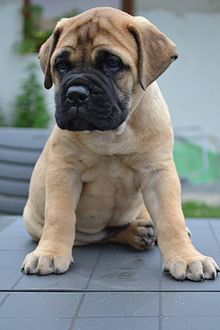Bullmastiff: Difference between revisions
ClueBot NG (talk | contribs) m Reverting possible vandalism by GatechWojo to version by TBarcus8. False positive? Report it. Thanks, ClueBot NG. (1968479) (Bot) |
GatechWojo (talk | contribs) Tag: gettingstarted edit |
||
| Line 61: | Line 61: | ||
* Keeper — Emily Bronte's dog, which she famously punched in the face when he would not stop sleeping on her bed |
* Keeper — Emily Bronte's dog, which she famously punched in the face when he would not stop sleeping on her bed |
||
* Swagger — The live mascot of the [[Cleveland Browns]] |
* Swagger — The live mascot of the [[Cleveland Browns]] |
||
* Bronx - The Bullmastiff that barks all the time for no reason (My house) |
|||
==See also== |
==See also== |
||
Revision as of 15:21, 26 September 2014
| Bullmastiff | |||||||||
|---|---|---|---|---|---|---|---|---|---|
 A red bullmastiff | |||||||||
| Origin | United Kingdom | ||||||||
| |||||||||
| Dog (domestic dog) | |||||||||
The bullmastiff is a large breed of domestic dog, with a solid build and a short muzzle. The bullmastiff shares the characteristics of Molosser dogs, and was originally developed by 19th-century gamekeepers to guard estates. The breed's bloodlines are drawn from the English Mastiff and Old English Bulldog. It was recognized as a purebred dog by the English Kennel Club in 1924. They are quiet dogs and very rarely bark.[1]
Appearance



Size
Males should be 25 to 28 inches (64 to 71 cm) tall (AKC Std.) at the withers and 110 to 130 pounds (50 to 59 kg). Females should be 24 to 26 inches (61 to 66 cm) at the withers, and 100 to 120 pounds (45 to 54 kg). Exceeding these dimensions is discouraged by breeders.
Color
A bullmastiff's coat may appear in fawn, red, or brindle. These are the only acceptable colors in the AKC standard.[2] The fawn can range from a very light brown to a reddish brown. Red can range from a light red-fawn to a dark rich red. Brindles are a striped overlay of the fawn or red. A bullmastiff should have no white markings, except for on the chest where a little white is allowed.
History
Bred by English gamekeepers in the 19th century to assist English wardens or gamekeepers guard estates and capture poachers. As a result the bullmastiff is known as the Gamekeeper's Night Dog. The Bullmastiff was a cross of 40% Old English Bulldog (not the short, chubby Bulldog of today) and 60% English Mastiff for its size, strength and loyalty. They bark much less often than other breeds; however, they will bark on alarm.
The bullmastiff was recognized as a pure-bred dog in 1924 by the English Kennel Club. In 1934 the American Kennel Club recognized the bullmastiff.[2] The first standard for the breed was approved in 1935.[3] The standard has undergone several revisions since then. The most current version is available on the AKC Web site.[4]
Trainability
Bullmastiffs are strong, powerful but sensitive dogs. For a bullmastiff to become a well-behaved family member, consistency is needed. Training and socialization is of high importance as the breed can be independent.[2] Dogs of this breed are natural guardians of their home and owners. No special guard training is needed for a bullmastiff to react appropriately if his family is endangered. During training, a bullmastiff requires a special approach, because these dogs do not like to repeat the same actions again and again. Activities bullmastiffs enjoy include obedience, agility, tracking, and carting.[1]
Health

A UK survey puts the median lifespan of the bullmastiff at 7 to 8 years old.[5] A bullmastiff will not stop growing until it is about three and a half years of age. Bullmastiffs are prone to certain hereditary diseases including:
- Hip dysplasia, affecting 24.5% of individuals [6]
Elbow dysplasia, affecting 13.8% of individuals,[7] entropion, hypothyroidism affecting 2.8% of individuals,[8] Lymphoma cancer , progressive retinal atrophy, a particular problem, since the trait is an autosomal dominant one. Although this has recently been called into question by another other medical team and has been proven there are bullmastiffs with Autosomal Recessive PRA Genes. In America, this is being investigated by the American Bullmastiff Health and Research Committee and the DNA Optigen test only works for dominant so is considered not adequate at this time.,[9] arthritis and bloat.
Cosmetic genetic problems include longhairs and "Dudleys". Both are recessives and not common. The Dudley, named after a notable Bulldog breeder of the 19th century, the Earl of Dudley, is a lack of pigment in the mask. It can be liver colored or simply not present.
Famous bullmastiffs
- Rocky — Roloff family dog (Little People Big World)
- Gus — Paul Teutul's dog (American Chopper)
- Butkus — Sylvester Stallone's dog, starring in Rocky II
- Keeper — Emily Bronte's dog, which she famously punched in the face when he would not stop sleeping on her bed
- Swagger — The live mascot of the Cleveland Browns
- Bronx - The Bullmastiff that barks all the time for no reason (My house)
See also
References
- ^ a b Bullmastiff Page
- ^ a b c "Get to Know the Bullmastiff", 'The American Kennel Club', Retrieved 29 May 2014
- ^ "1935 Bullmastiff standard" (PDF).
- ^ American Kennel Club — Bullmastiff
- ^ "Individual Breed Results for Purebred Dog Health Survey". Retrieved 26 June 2012.
- ^ Orthopedic Foundation for Animals. "Hip Dysplasia Statistics". Retrieved 2013-06-11.
- ^ Orthopedic Foundation for Animals. "Elbow Dysplasia Statistics". Retrieved 2013-06-11.
- ^ Orthopedic Foundation for Animals. "Thyroid Statistics". Retrieved 2013-06-11.
- ^ "PRA". Swedish Bullmastiff Club.
